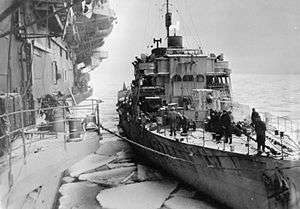HMS Honeysuckle (K27)
HMS Honeysuckle was a Flower-class corvette that served with the Royal Navy during the Second World War. She served as an ocean escort in the Battle of the Atlantic. [1][2][3]
 HMS Honeysuckle coming alongside the aircraft carrier Trumpeter in the Kola Inlet | |
| History | |
|---|---|
| Name: | Rhododendron |
| Ordered: | 31 August 1939 |
| Builder: |
|
| Laid down: | 26 October 1939 |
| Launched: | 22 April 1940 |
| Commissioned: | 14 September 1940 |
| Out of service: | 1950 – sold to T.W. Ward |
| Identification: | Pennant number: K27 |
| Fate: | sold 1950; scrapped November 1950 |
| General characteristics | |
| Class and type: | Flower-class corvette (original) |
| Displacement: | 925 long tons (940 t; 1,036 short tons) |
| Length: | 205 ft (62.48 m)o/a |
| Beam: | 33 ft (10.06 m) |
| Draught: | 11.5 ft (3.51 m) |
| Propulsion: |
|
| Speed: | 16 knots (29.6 km/h) |
| Range: | 3,500 nautical miles (6,482 km) at 12 knots (22.2 km/h) |
| Complement: | 85 |
| Sensors and processing systems: |
|
| Armament: |
|
Background
The ship was commissioned on 31 August 1939 by Harland and Wolff from Port Glasgow in Scotland. [4]
War service
On 20 September 1941, HMS Honeysuckle picked up 51 survivors from the CAM ship Empire Burton, which was torpedoed by the German U-boat U-74. That same day, she picked up an additional 22 survivors from the tanker T.J. Williams, which has torpedoed by a different U-boat, U-552. On 4 July 1943, she picked up 276 survivors from the merchant St. Essylt, which was torpedoed by U-375 off of Algeria.[1]
Sources
- Gardiner, Robert (1987). Conway's All the World's Fighting Ships 1922-1946. London: Conway Maritime Press. ISBN 0-85177-146-7.
- Preston, Antony; Raven, Alan (1982). Flower Class Corvettes. London: Arms and Armour Press. ISBN 0-85368-559-2.
- Friedman, Norman (2008). British Destroyers & Frigates - The Second World War and After. Barnsley, UK: Seaforth Publishing. ISBN 978-1-84832-015-4.
References
- "HMS Honeysuckle (K 27) of the Royal Navy - British Corvette of the Flower class - Allied Warships of WWII - uboat.net". uboat.net. Retrieved 2017-03-08.
- "HMS honeysuckle in the Great War - The Wartime Memories Project -". www.wartimememoriesproject.com. Retrieved 2017-03-08.
- "HMS Honeysuckle - World Naval Ships Directory". www.worldnavalships.com. Retrieved 2017-03-08.
- Friedman, Norman s. 340
- "Flower Class Corvettes HMS Honeysuckle". www.worldnavalships.com. Retrieved 2017-03-29.
gollark: You can just give it privileged access of some kind.
gollark: How Dockerious.
gollark: Wait, you run your Prometheus exporters in separate containers to the actual services?
gollark: Just have a script order more RAM when you run out.
gollark: We offer instantaneous, mandatory shipping!
This article is issued from Wikipedia. The text is licensed under Creative Commons - Attribution - Sharealike. Additional terms may apply for the media files.